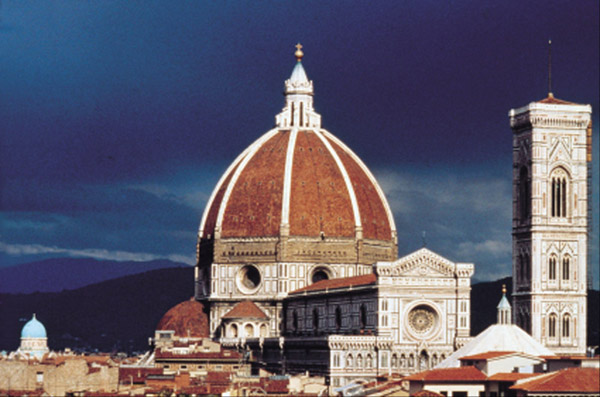
In a valley on the banks of the Arno river and set among lox hills covered with olive groves and vineyards, Florence is immediately captivating. Cradle of the Renaissance and home of Machiavelli, Michelangelo and the Medici, the city seems unfairly burdened with art, culture and history.
Despite the relentless traffic, stifling summer heat, pollution and industrial sprawl on the city’s outskirts, Florence attracts millions of tourists each year. The French writer Stendhal was so dazzled by the magnificence of the Basilica di Santa Croce that he was barely able to walk for faintness. He is apparently not the only one to have felt overwhelmed by the beauty of Florence – they say Florentine doctors treat a dozen cases of “Stendhalismo” a year.
History
The Etruscan city of Fiesole founded Florence as a colony in about 200 BC. It later became the Roman Florentia, a strategic garrison whose purpose was to control the Via Flaminia linking Rome to northern Italy and Gaul. Along with the rest of northern Italy, the city suffered during the barbarian invasions of the Dark Ages. In the early 12th century it became a free comune (town council) and by 1138 was ruled by 12 priori (consuls), assisted by the Consiglio di Cento (Council of One Hundred). The council members were drawn mainly from the prosperous merchant class. Agitation among differing factions in the city led to the appointment of a foreign head of state, known as the podestà, in 1207.
In the 15th century Cosimo de’ Medici emerged as the head of the opposition to the Albizzi and eventually became Florence’s ruler. His eye for talent and his tact in dealing with artists saw the likes of Alberti, Brunelleschi, Lorenzo Ghiberti, Donatello, Fra Angelico and Fra Filippo Lippi flourish under his patronage. Many of the city’s finest buildings are testimony to his tastes.
Cosimo was eventually followed by his grandson, Lorenzo il Magnifico, whose rule ushered in the most glorious period of Florentine civilization and of the Italian Renaissance. His court fostered a great flowering of art, music and poetry, turning Florence into the cultural capital of Italy. Lorenzo favoured philosophers, but he kept up a family tradition by sponsoring artists such as Botticelli and Domenico Ghirlandaio; he also encouraged Leonardo and the young Michelangelo, who was working under Giovanni di Bertoldo, Donatello’s pupil.
Not long before Lorenzo’s death in 1492, the Medici bank failed and two years later the Medici were driven out of Florence. The city fell under the control of Girolamo Savonarola, a Dominican monk, who led a puritanical republic until he fell from public favour and was fried as a heretic in 1498.
After Florence’s defeat by the Spanish in 1512, the Medici returned to the city but were once again expelled, this time by Emperor Charles V in 1527. Two years later they had made peace and Charles not only allowed the Medici to return to Florence, but married his daughter to Lorenzo’s great-grandson Alessandro de’Medici, whom he made Duke of Florence in 1530. The Medici then ruled for another 200 years, during which time they gained control of all Tuscany.
In 1737 the Grand Duchy of Toscana passed to the House of Lorraine, which retained control (apart from a brief interruption under Napoleon from 1799 to 1814) until it was incorporated into the Kingdom of Italy in 1860. Florence became the national capital a year later, but Tome assumed the mantle permanently in 1875.
Florence was badly damaged during WWII by the retreating Germans, who blew all its bridges except the Ponte Vecchio. Devastating floods ravaged the city in 1966, causing inestimable damage to its buildings and artworks. However, the salvage operation led to the widespread use of modern restoration techniques hat have saved art-works throughout the country.
Orientation
Whether you arrive by train, bus or car, the central trains station, Santa Maria Novella, is a good reference point. The main route to the city centre is Via de’ Panzani and then Via de’ Cerretani, about a 10 minute walk. You will know you have arrived when you first glimpse the Duomo.
Most of the major sights are in easy walk-distance; you can stroll from one end of the city centre to the other in about 30 minutes. From Piazza San Giovanni next to the Duomo, Via Roma leads to Piazza della Repubblica and continues as Via Calimala and Via Por Santa Maria to the Ponte Vecchio.
Take Via de’ Calzaiuoli from Piazza del Duomo for Piazza della Signoria, the historic seat of government; do not be fooled by the copy of Michelangelo’s David outside the Palazzo Vecchio; the real one is in the Galleria dell’Accademia. The Galleria degli Uffizi is on the piazza’s southern edge, near the Arno. Cross the Ponte Vecchio, or the Ponte alle Grazie farther east, to reach Piazzale Michelangelo, in the south-east for a view over the city, one of the best vistas in Italy.
You will find reasonably priced public parking around the imposing Fortezza Basso, just north of the main station Santa Maria Novella and a brisk 10 minute walk to the historic centre along Via XXVII Aprile and Via Cavour.